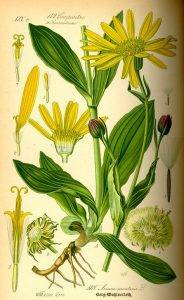
Arnica – Arnica montana L.
Description of Arnica:
Arnica montana (Old or known names: capeflower, angelica root, motherwort, shadowwort, feverfew, lucerne, marjoram, marigold, Italian buttercup, St. John’s wort) Nests – Compositae The stems of the arnica, which remain in the ground and grow horizontally or downwards in a rhizome, are called rhizomes. This stem is 10 cm long, 6-8 mm, rarely 1 cm thick, yellowish-brown in colour, white inside. Tiny thread-like roots emerge from the lower side. The upright stem, 30-60 cm tall and 4-8 mm thick, emerges from the rootstock which remains in the ground, but is only an annual and withers with the leaves in autumn. The stem is hairy and is densely covered with reddish sticky glandular hairs on the upper part; it bears a nest with 1-3 flower heads on top. The leaves on the stem are opposite one another in twos; the lowest two pairs of leaves are very densely arranged above one another, forming a rosette of leaves. In addition to these, the stem bears 1-2 pairs of leaves. All leaves are elongated, ovate or lanceolate, sessile, sessile, with slightly pillate margins. The bracts are 8-10, rarely 20 cm long and 2-4, rarely 7 cm wide. Those on the stem are smaller. Flowers are yellow. The apex of the stem is occupied by a single large yellow flower-head, and a lateral branch with a single flower-head emerges from the axils of the upper leaves (sometimes also from the lower ones). Two or two small, narrow leaflets are spaced apart below each flower head. The flower head is 6-7 cm in diameter and is surrounded on the outside by a collar of green leaflets, which serve to protect the immature flowers when they are in bud. The arnica flowers in June and July.
Occurrence of arnica:
The arnica grows in damp, mainly peaty, marshy conifer meadows. It never grows on calcareous soils. In our country it is found only in the mowing meadows of the north-eastern and Transylvanian snowfields, where it can reach down to the snow-bed landscape. In the west it ranges as far as Gömörmegye, but it occurs sporadically in the western part of the country and on the final foothills of the Alps.
Medicinal properties and uses of arnica:
Arnica has a peculiar, strong but not unpleasant, slightly pungent smell and a pungent, bitter taste. It has a strong stimulant effect. It contains a specific bitter substance called arnicin. In addition, it contains a small amount of volatile oils and resinous substances. In the past, arnica was used in medicine to a greater extent than it is today. It used to be used internally and externally for a variety of ailments, but is no longer used internally. However, the tincture of arnica made from its flowers is still highly prized by the people, who use it for rubbing and poultices. All parts of arnica are sold in the herb trade; the flowers of arnica are most sought after, while the leaves are less frequently used. Its root or capital, dried, is sold under the name radix, or more correctly rhizoma arnicae; its leaves, and possibly also its stems, are called herba v. folia arnicae; its flowers are called flores arnicae, and finally the whole flower-flowers are called flores arnicae cum caycibus. (Its medicinal use was very extensive, and it used to be official in our herbal pharmacopoeia.)
Active ingredient:
Essential oil, and more in the fresh than in the dry, besides arnicin, tannic acid, blue resin, jegeous fat, and wax. The root stem also contains 10% inulin.
Taking arnica:
The stems and roots of arnica are dug in spring or autumn. The dug up stems, which are about a finger’s thickness thick, are cleaned of soil and quickly dried in a sunny place. When they are so dry that they break easily, they are bagged and transported. 5 kg of fresh arnica roots will yield 1 kg of dry roots; 100 kg costs 60 crowns. The flowers are harvested in June or July. Harvesting is done in clear weather, after the dew has dried up. Do not pick the chewed and degenerated flower heads, as they are infested with insect larvae, which could cause great damage to our harvested stock if they chew and soil the dried flowers. When collecting flowers, we pick the whole flower heads and take them home. Dry the picked flowers quickly, which is why they should be laid out on a tarpaulin and dried in the sun. 5 kg of fresh flowers will produce 1 kg of dry flowers. The completely dry flowers are packed in crates. For a safer preservation, take special care to clean the flower heads of any insects hiding in them, otherwise the flower heads will suffer a lot from insect damage. In particular, the stem at the base of the flower head is home to the chrysalis of a small fly(Trypeta arnicivora), which can cause great damage if it remains in the flower head. For this reason, the individual yellowish flowers are plucked from the dried flower heads and separated from the stem part of the flower head on which the flowers were standing and from the green collar leaves surrounding the nest.
Pest control:
The flowers can be plucked from the head and dried separately before drying. Insect larvae are often hidden in the healthy-looking flower heads, which can be harmful to dried flowers, so it is a good idea to dry the picked flower heads suddenly over a sieve or in the oven, killing the insects hiding in the flower heads. You can make your goods more valuable and avoid insect bites, but picking and drying only the yellow flowers of the flower heads with the tongue-shaped blossoms will be less profitable. The flowers of arnica are easily interchanged with those of other plants with nesting flowers, namely the flowers of the painter’s pipe-wort(Anthemis tinctoria), the marigold(Calendula officinalis), thedornicum (dornicum) and theinula britanica (inula britanica), and the latter flowers are used to adulterate the flowers of arnica. They differ from all these in that, on the one hand, the edge of the head on the flange has three teeth and, on the other hand, the small fruit has a pistil, whereas marigolds and pipitera have no pistil and only the middle fruit in the nest of the foxglove has a pistil and the flowers on the flange have no pistil.
Artificial propagation:
It would be worthwhile to propagate arnica artificially. It can be grown in coniferous areas, in harsh fens, in clearings in cold woods, in wet, marshy places with high rainfall, because it does not survive in dry places with warmer climate. In pastures and meadows in the grasslands of the north, it can be propagated by ploughing up, dusting and sowing with grass seed, mixed with 1/3 of the seeds. This is sown and scattered in August or early spring. In this way you get a better grass crop and you can also harvest the arnica, because from the second year onwards you can harvest the flowers, and from the 3rd and 4th year onwards you can harvest the roots Propagation according to Dr. Ferenc Darvas: Since the wild areas of arnica have been taken away from us by the mutilation of our country, and because of our climatic conditions it is hardly economically producible in our mutilated country, – we are dependent on imports for this drug – It can be grown in mountainous regions, in wooded, moist meadows, and can be propagated by sowing seeds or by division. It can also be sown directly in the open air, in which case the arnica seed is sown in the ploughed, prepared soil in August-September, with about half a quantity of grass seed. Alternatively, the seeds can be used to grow seedlings, which are planted about 30 cm apart in the spring. Seed requirement per acre: 300 grams. It is propagated by dividing the rootstock by splitting it. Source: Dr. Ferenc Darvas and Dr. Gyula Magyary-Kossa,Domestic medicinal plants, their production, marketing, effects and medicinal uses Béla Páter, Wild medicinal plants, their production, use, distribution, and marketing
